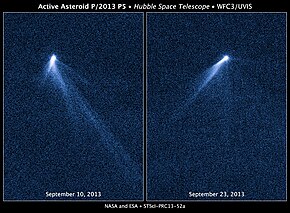 P/2013 P5 (PanSTARRS) as captured by the Hubble Space Telescope P/2013 P5 (PanSTARRS) as captured by the Hubble Space Telescope | |
| Discovery | |
|---|---|
| Discovered by | Bryce T. Bolin using Pan-STARRS |
| Discovery date | 27 August 2013 |
| Designations | |
| Alternative names | P/2013 P5 (PANSTARRS) |
| Minor planet category | |
| Orbital characteristics | |
| Epoch 16 November 2013 (JD 2456612.5) | |
| Uncertainty parameter 0 | |
| Observation arc | 13.13 yr (4,797 d) |
| Earliest precovery date | 17 January 2005 |
| Aphelion | 2.4411 AU |
| Perihelion | 1.9362 AU |
| Semi-major axis | 2.1885 AU |
| Eccentricity | 0.11530 |
| Orbital period (sidereal) | 3.24 yr (1182.575d) |
| Average orbital speed | 0.3044°/d |
| Mean anomaly | 314.07° |
| Inclination | 4.9685° |
| Longitude of ascending node | 279.29° |
| Time of perihelion | 2024-Jan-01 |
| Argument of perihelion | 144.26° |
| Physical characteristics | |
| Mean diameter | ~480 meters (1,570 ft) |
| Mean density | 3.30 ± 0.20 g/cm |
| Escape velocity | ~0.240 m/s |
311P/PanSTARRS also known as P/2013 P5 (PanSTARRS) is an active asteroid (object with asteroid-like orbit but with comet-like visual characteristics) discovered by Bryce T. Bolin using the Pan-STARRS telescope on 27 August 2013. Observations made by the Hubble Space Telescope revealed that it had six comet-like tails. The tails are suspected to be streams of material ejected by the asteroid as a result of a rubble pile asteroid spinning fast enough to remove material from it. This is similar to 331P/Gibbs, which was found to be a quickly-spinning rubble pile as well.
Three-dimensional models constructed by Jessica Agarwal of the Max Planck Institute for Solar System Research in Lindau, Germany, showed that the tails could have formed by a series of periodic impulsive dust-ejection events, radiation pressure from the Sun then stretched the dust into streams.
Precovery images from the Sloan Digital Sky Survey from 2005 were found, showing negligible cometary activity in 2005.
Characteristics
The asteroid has a radius of about 240 meters (790 ft). The first images taken by Pan-STARRS revealed that the object had an unusual appearance: asteroids generally appear as small points of light, but P/2013 P5 was identified as a fuzzy-looking object by astronomers. The multiple tails were observed by the Hubble Space Telescope on 10 September 2013, Hubble later returned to the asteroid on 23 September, its appearance had totally changed. It looked as if the entire structure had swung around. The Hubble Space Telescope continued to track the object through 11 February 2014. The comet-like appearance has resulted in the asteroid being named as a comet. The object has a low orbital inclination and always stays outside the orbit of Mars.
Possible satellite
On April 19, 2018, observations based on light curvature suggested a possible satellite around 311P/PANSTARRS approaching 200 meters. If true this would be one of the few minor planets designated as a comet known to harbor a satellite.
See also
- 354P/LINEAR (P/2010 A2)
- Yarkovsky–O'Keefe–Radzievskii–Paddack effect (aka YORP effect)
References
- ^ Bolin, B.; et al. (27 August 2013). "CBET #3639 : P/2013 P5 (PANSTARRS)". Central Bureau Electronic Telegrams. 3639. Central Bureau for Astronomical Telegrams: 1. Bibcode:2013CBET.3639....1B. Archived from the original on 21 September 2020. Retrieved 27 August 2013.
- ^ "JPL Small-Body Database Browser: P/2013 P5 (PANSTARRS)" (2013-11-07 last obs). Retrieved 9 November 2013.
- "Horizons Batch for 311P/PANSTARRS on 2024-Jan-01" (Perihelion occurs when rdot flips from negative to positive). JPL Horizons. Retrieved 29 August 2022. (JPL#29/Soln.date: 2021-Apr-15)
- ^ Jewitt, D.; Agarwal, J.; Weaver, H.; Mutchler, M.; Larson, S. (2013). "The Extraordinary Multi-Tailed Main-Belt Comet P/2013 P5". The Astronomical Journal. 778 (1): L21. arXiv:1311.1483. Bibcode:2013ApJ...778L..21J. doi:10.1088/2041-8205/778/1/L21. S2CID 67795816.
- "When is a comet not a comet?". Spacetelescope. 7 November 2013.
- ^ "NASA's Hubble Sees Asteroid Spouting Six Comet-Like Tails". Hubblesite. 7 November 2013.
- "She calculated that dust-ejection events occurred on April 15, July 18, July 24, Aug. 8, Aug. 26 and Sept. 4"
- "When is a comet not a comet?". ESA. 7 November 2013.
- "Hubble astronomers observe bizarre six-tailed asteroid". Spacetelescope. 7 November 2013.
- "311P/PANSTARRS Orbit". Minor Planet Center. Retrieved 13 September 2014.
- "Other reports of asteroid/TNO companions".
External links
- The Multi-Tailed Main-Belt Comet P/2013 P5 (Remanzacco Observatory : 8 November 2013)
- Confused Asteroid Sprouts Tails… Six of Them! (Phil Plait : 8 November 2013)
- Orbit diagram from JPL Small-Body Database
| 2013 in space | ||||||
|---|---|---|---|---|---|---|
| Space probe launches |
|    | ||||
| Impact events | ||||||
| Selected NEOs | ||||||
| Exoplanets |
| |||||
| Discoveries |
| |||||
| Novae | ||||||
| Comets | ||||||
| Space exploration |
| |||||

